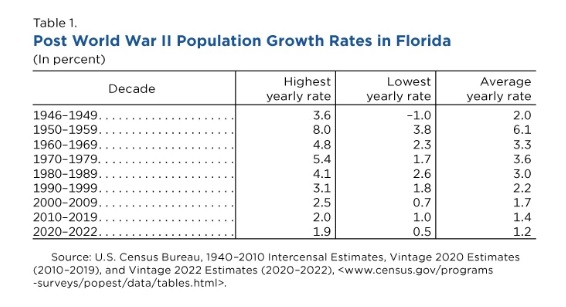
LEWISTON, ID – After decades of rapid population increase, Florida now is the nation’s fastest-growing state for the first time since 1957, according to the U.S. Census Bureau’s Vintage 2022 population estimates.
Florida’s population increased by 1.9% to 22,244,823 between 2021 and 2022, surpassing Idaho, the previous year’s fastest-growing state.
For the third most-populous state to also be the fastest growing is notable because it requires significant population gains.
From Idaho Department of Labor:
The U.S. Census Bureau estimated Idaho’s July 2022 population at 1,939,033, an increase of 1.8% from July 2021, ranking it second nationally in percentage growth. Idaho grew about four times faster than the national growth rate of 0.4%.
The new Census estimate shows Idaho’s population growth is slowing down to 2016 levels, falling below its five-year average growth rate of 2.3%. For the first time in five years, the state was not in the top spot for new residents.
Florida outpaced all 50 states and the District of Columbia adding 416,754 new residents — up 1.9%.
Numerically, Idaho is 10th in the nation for its population increase of 34,719 people. In 2021 the state ranked ninth in the nation and swelled by more than 50,000 people.
Idaho’s net in-migration accounted for about 88% of its growth from 2021, while natural change — when births outnumber deaths — accounted for approximately 11%. Net international in-migration more than tripled in Idaho compared with 2021, a trend across all 50 states and the District of Columbia. Census Bureau analysts speculate the loosening of COVID-19-related travel restrictions allowed for more international migration. Still, immigrants from other countries accounted for only 5% of Idaho’s population growth at fewer than 2,000 people.
The U.S. population increased by three-tenths of a point in 2022 and grew faster than in 2021, which is considered a year of record low growth. This national population gain was driven by a rebound in net international in-migration of 168.8%. These gains moved the total number of new immigrants and new babies added to the U.S. population above 1 million people, compared with fewer than 400,000 in 2021.
Births outweighing deaths were prevalent in 26 states, while 18 states experienced a population decline. Idaho ranked 16th in the number of babies born over deaths, compared to its No. 10 rank in new residents overall.
Idaho’s 2021 estimate was revised with this release, reflecting an uptick of 3,391 new residents — up 3% compared to the 2021 forecast of 2.9%.
Population estimates for 2022 will be released next spring for metropolitan statistical areas, counties and cities, according to the U.S. Census Bureau.
From U.S. Census Bureau:
Florida a Consistent Top Gainer
In the post-World War II era after 1946, Florida’s percentage increase in population each year has fluctuated but has always been positive (Figure 1).
In the 1950s, as air conditioning became more prevalent in warmer parts of the United States, Florida’s annual population growth averaged 6.1% (Table 1). It hit 8% in both 1956 and 1957, near the peak of the baby boom, marking the last time Florida was the fastest-growing state — until now.
During that decade, Florida’s growth far outpaced the national rate, which was between 1.5% and 2% each year that decade. An annual population growth of 8% is exceptionally rapid and translates to a population doubling roughly every nine years.
Florida Grew Even When U.S. Population Increase Slowed
The baby boom (1946-64) came to an end in the 1960s and Florida’s extraordinary growth during the 1950s slowed. However, “slowed” is a bit of a misnomer since, between 1960 and 1989, Florida’s average annual growth remained over 3.0%. Generally, The Sunshine State’s population grew at a rate about double the national average.
In the 2000s, the slowing trend continued with Florida averaging an annual growth of 1.7%. While this might seem slow compared to Florida’s growth in prior years, it is still a brisk pace. During the same period, the national growth hovered around 1.0% a year.
That trend has continued since 2010. Between 2010 and 2020, national growth dipped from 0.9% to 0.5% each year while Florida’s increases ranged from 1.0% to 2.0%. In 2022, Florida’s growth was nearing that previous decade high at 1.9%, not high compared to past gains but still the fastest among the states. Interestingly, Florida had the second-largest numeric gains behind Texas.
Vintage 2022 population estimates scheduled for release over the next few months will shed light on which areas and demographic groups contributed to the state’s growth.
What Are the Fastest-Growing States?
Why hasn’t Florida been the country’s fastest-growing state in any other year since 1957?
In a word — Nevada.
Florida’s percentage gains since 1946 have been impressive: its 2022 population is just over 9 times its 1946 population of 2,440,000.
But Nevada’s increases are even higher. Its 2022 population of 3,177,772 is a stunning 22 times its 1946 population of 143,000. For 36 of the 76 years since 1946, Nevada has held the top spot.
Arizona, Idaho, Utah, North Dakota, and Alaska are among the other fastest-growing in the postwar era.
User note: The intercensal estimates datasets used do not contain July 1 estimates for 1970 and 1980; for those two years, the estimates were interpolated using the previous/next year and then change based on the new estimated value.
The intercensal estimates for 2010-2019 have not yet been released. For this period, we used the Vintage 2020 postcensal estimates.


